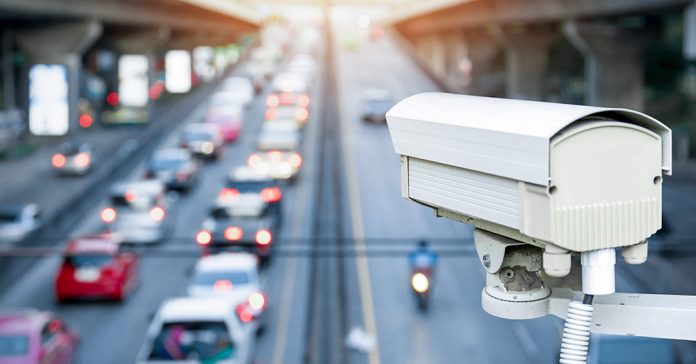
The traffic laws in the country are constantly changing because of the ongoing issue of heavy traffic, especially in the more metropolitan areas of the country. There are many policies in place that we have to keep track of because the powers that be have them in place to hopefully alleviate traffic congestion.
With that in mind, if you have been driving around the streets of Metro Manila anytime in the past year or so, you might have noticed a few signs that say “No Contact Apprehension Policy in Effect” plastered in some places but not in others. If you’ve wondered what those are about and how they will change your life as a motorist or driver in the Metro Manila area, then this article is for you.
Let’s first start by covering what exactly is the No Contact Apprehension Policy that you’ve heard about lately.
What is the No Contact Apprehension Policy or NCAP?
The No Contact Apprehension Policy, or NCAP for short, is a policy that placed several Closed-Circuit Televisions or CCTVs, digital cameras, and all sorts of monitoring devices in certain parts or streets to capture erring or drivers violating traffic laws in the country.
They will then use the footage or documentation of an erring driver’s violation to fine them or apprehend them at a later date after they send the notice to the driver. Usually, they do this not on the same day of the violation but some days after committing it.
Therefore, getting caught by the NCAP means that no traffic enforcer will be stopping your vehicle for said violation caught on the surveillance. Hence, the no-contact apprehension aspect. That means that just because there isn’t a traffic enforcer there to catch you then you may still get fined, as long as you were caught by these cameras.
Who is responsible for this policy?
The Metro Manila Development Authority or MMDA would be the ones responsible for overseeing or enforcing this policy. Aside from that, the MMDA will work with the local governments of the cities participating in this policy. Therefore, they have the guidance and cooperation of whichever local government these policies are in as well.
Aside from that, they also all work together with the Land Transportation Office or the LTO for this entire policy and its operations and enforcement. All three of them will operate together to enforce, enact, and maintain this policy in the areas where it is in effect.
What is the coverage of this policy?
Since the MMDA is the one managing this policy, then you can expect that this policy is mostly or only applicable to Metro Manila, where traffic is particularly painful for motorists. However, not all parts of Metro Manila have the NCAP in effect. There are only specific areas where you will see these surveillance cameras around.
The cities in Metro Manila that are participating in the NCAP are:
- Manila City
- Paranaque City
- Quezon City
- Valenzuela City
However, there are also a few parts outside of the NCR where NCAP is in effect. These would be:
- Bataan Province
- Cauayan City in Isabela
- Mandaue City in Cebu
You will usually find a sign that states that an area would be covered by this policy so that you can behave yourself while on the road.

What Happens When You Get Caught Violating Traffic Rules Where NCAP is In Practice?
Now that you know what exactly is the NCAP, you might find yourself asking what happens if you do find yourself in a situation where you get caught violating traffic rules. Well, there are several things that can happen.
How will you receive the notice of violation from the MMDA?
Since you won’t encounter a traffic enforcer when they catch you violating traffic laws via the surveillance cameras in place in places where NCAP is in practice, the MMDA will notify you of your violations differently.
As mentioned earlier, this policy is in cooperation with the LTO and MMDA, and local government. Therefore, they will use your license plate and the RFID on your vehicle to track the owner or registered owner of the vehicle as well as their address.
They will then send you a Notice of Violation through the Philippine postal system, so you can expect that this will take some time before you will receive the notice.
How will the MMDA know about the records of the vehicle?
The MMDA will work with the LTO and use your license plate and RFID as a reference for who owns the vehicle. They will then use that information to know which address to send the notice to, so it depends on whose name is registered as the owner of the vehicle.
In some cases, the MMDA might work with local governments to ensure that you receive their mail.
What will happen if the violator refuses to receive the notice?
Some people can get mad if they find that they received a Notice of Violation because they were caught by the NCAP. When they do, there will be cases where the violator will refuse to receive the notice that comes to them.
If you keep the Notice but ignore it, then you’re still going to get hefty fines from it. However, there will usually be a report that states that you have received the Notice but have refused to accept it. Instead of just outright ignoring it and tangling up your problem even more, you should instead opt to challenge it, which we’ll cover later.
When will the violator receive the notice after committing a violation?
As you know, the Notice of Violation goes through the postal system or snail mail. Therefore, you can’t expect to receive a notice of your violation the day of or even after you commit said violation. The delivery of the notice will depend on the courier because the NCAP office of the MMDA delivers these notices in batches rather than on a per instance basis.
How many days does the violator have to pay off or settle their dues under the NCAP?
A good rule to follow is to make sure that you pay off the dues within seven days after receiving the Notice of Violation. However, there are some cases where you can pay it off after ten days, but it will depend on the local government. If it’s from the MMDA themselves, then seven days is the maximum. To be safe, pay it off before the seven days are up regardless of whether it’s the MMDA or the local government that’s fining you.
What if you want to contest the violation against you?
If you know that you have a strong case against this violation or you have a legitimate reason behind why you committed the violation, then you should contest it.
The forms and documents that you will need will differ depending on who you need to contest, such as if it’s the local government or the MMDA that you have to contest.
However, you will usually need the following documents:
- The Notice of Violation
- A Notarized Protest Form or Notarized Appeal of some kind
- Proof of Emergency (optional, but highly recommended)
- Driver’s License
For the MMDA, if they reject your appeal, you can submit a Motion for Reconsideration within 15 days after the rejection. If even that motion is rejected, you can then send an appeal to the Office of the Chairman within 30 days after the second rejection. There aren’t any other steps that you can take if you get rejected up to this point, except facing the music and paying the fines.
What if you committed the violation because of an emergency?
If you’re going to contest the claims of violation against you because you did it due to an emergency, then many will be more lenient and accept your appeal. Therefore, it’s best that if possible, you get yourself a proof of emergency when you submit your motion for reconsideration or when you first contest the violation.
Payment or Fine Settlement Questions About the NCAP
If you find yourself caught by the NCAP and are now thinking about paying off the fines that you accrued or have any questions about them, then here are some answers to these questions.
How do I know if I have any unsettled violations caught by the NCAP?
Since it does take a while before you ever get the Notice of Violation, if you feel that you got caught by the cameras and want to check if you did commit a traffic violation, then there are ways for you to check that.
The MMDA made it easier for you to check that by going online and going to their MAY HULI BA? Website. You simply enter your car’s plate number so that you can check if you have any outstanding or unsettled fines.
Where can you pay or settle the violations or fines?
Where you pay your fines will depend on who you have to answer to regarding these violations.
If you’re going to pay your fines to the MMDA, then you have three options:
- Pay via the MMDA Main Office
- SM Bills Payment kiosks
- Bayad Center
If you’re answering to a local government office, then the payment options can expand to the following:
- City Hall of the city that fined you
- Online Payment Options
- Accredited Payment Outlets
- Over-the-Counter at banks
- Online banking portals
It’s best to check the website of the city where you got the fine to know which payment options they accept.
What happens if you don’t pay your settlement or your fines?
If you ignore the summons or the Notice of Violation, the powers that be will still record that they’ve delivered the notice to you. Even if you ignore the notice, they will still be counting that against you. If you refuse to pay your fines, then you will face consequences.
The LTO will then put your car’s license plate on their to-watch list or alarm list so that you won’t be able to renew your car’s registration until you pay your fines.
When should you pay your penalties or fines?
You have either seven or ten days before you will get more penalties for not paying your fines. However, it’s a good idea to do it as early as possible since you might forget. In some places, it can even be as few as five days. It’s best to check the website of the local government that you need to pay to, or pay before seven days pass if it’s for the MMDA.
Other Frequently Asked Questions About the No Contact Apprehension Policy
Here are a few other questions you may have about the No Contact Apprehension Policy that we might not have covered yet.
What are the contact numbers, hotlines, or ways to contact the MMDA regarding an NCAP violation or other concerns?
If you want to get in touch with an MMDA officer regarding any concerns you have about the NCAP, then you can contact the Redemption Center via telephone with their number 8882-2629 loc. 1164/1165.
On the other hand, if you want to directly contact the MMDA NCAP office, then you can reach out to them via phone or email. Their phone number is 8882-4151 loc. 1084 and their email would either be noncontact@mmda.gov.ph or mmda.ncap.2016@gmail.com.
The vehicle is registered under my name, but I’ve already sold it to someone else when it was caught under the NCAP. Am I the one who has to pay the fine?
Since the vehicle is under your name, you will need to answer for the violation. It is your responsibility to make sure that they continue with the change of registration.
However, you can always file a complaint and contest the violation by showing a Deed of Sale and getting a notarized Complaint. You can then head to the MMDA office and show them the name and address of the driver or supposed owner of the vehicle after they failed to register the vehicle under their name.
What can I do if I wasn’t driving the vehicle when caught under the NCAP?
If you are the owner of the vehicle, but you weren’t the one who was driving the vehicle when it committed the violation, then you can also file a complaint to the right authorities so that you can nominate the driver for the violation.
However, if the driver you nominated fails to pay the violation after ten days, the owner of the vehicle will then be held accountable and secondarily responsible for the violation committed with his vehicle. Therefore, you will have to pay the fine still.
My car was stolen and caught under the NCAP. What do I do?
You will have to show the police report or LTO report citing that the vehicle in question under your name was reported stolen when it incurred the violation. Aside from that, you will need to also file a notarized Complaint with it all before the deadline.
Are there still MMDA Traffic Enforcers in places with NCAP in place?
Yes, there can still be traffic enforcers in the cities where there is NCAP in practice. Therefore, you will need to be mindful of your driving and make sure that you don’t violate any traffic laws in these areas.
How Effective Has the No Contact Apprehension Policy Been Since Application?
Since you’re accommodating the NCAP and learning to adapt to it, let’s cover just how effective the NCAP has been.
Public Response to the NCAP
Many motorists were less than pleased with the NCAP, but many are under the wrong impression that this policy was out of nowhere. In fact, this policy has been in effect since 2016, but it’s only recently that this policy has really been proactively enforced. Thus, there are a lot of drivers that aren’t happy about the NCAP because there are some gaps in the system.
Is the No Contact Apprehension Policy still in effect?
The Supreme Court has ordered the suspension of this policy for some local government units and areas until they weigh the pros and cons of this policy. For now, this suspension will last until the year 2023 when they will give proponents and critics of this policy a chance to discuss this policy and its effects.
In Conclusion
Knowing what the No Contact Apprehension Policy is about will help you be more aware of your surroundings and make sure that you are following the traffic rules with or without the presence of a traffic enforcer. Hopefully, this article has helped you understand what to do in specific situations regarding this policy if you ever have to deal with it first-hand.




